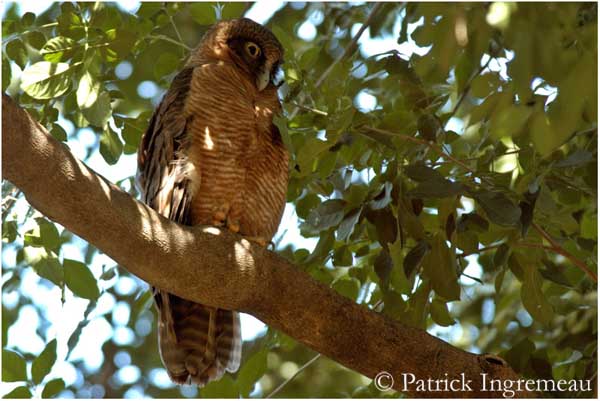
Rufous Owl
Ninox rufa
Strigiforme Order – Strigidae Family
BIOMETRICS:
Length : 46-57 cm
Wingspan : 100-120 cm
Weight : M : 1200 g – F : 980g
DESCRIPTION:
Rufous Owl is a large owl of tropical rainforests, with small head and long tail.
Adult male has dark rufous upperparts, with fine pale brown bars. Uppertail shows broader bars.
Underparts are paler, rich rufous, with fine buffy-white bars. Underwings and undertail are pale brown, with broad buffy-white bars.
On the head, forehead, crown and nape are rich rufous as upperparts. We can see an indistinct dark brown facial disk, with whitish patch between eyes.
Hooked bill is grey to pale horn, and with short black bristles at base. Eyes are golden-yellow. Feathered legs are rich rufous. Toes are creamy-coloured with black talons.
Both sexes are similar in plumage, but male is larger than female, and it has broader and flatter head.
Juvenile is much smaller and partly downy.
Immature shows broader rather dark brown bars than adults.
We can find 4 subspecies which differ in size and intensity of colours.
N.r. humeralis is smaller and browner.
N.r. queenslandica is larger and darker, with paler underparts.
N.r. aruensis is sometimes considered as Aru population, but it is similar to N.r. humeralis.
N.r. meesi could be a pale morph of N.r. queenslandica.
REPRODUCTION:
Breeding season varies from June to September, sometimes earlier in warm regions.
Nest is often placed in dead tree, sometimes living tree. It is a large hollow in the trunk or in large branch, often situated high in large tree, at about 30 metres above the ground, but occasionally nest can be found lower, at about 3 metres of height.
Male prepares the hole and cleans it out. Female enters just before laying.
She usually lays 2 dull white eggs, sometimes only one. Incubation lasts about 36 to 38 days, by female. She is probably fed at nest by male.
Chicks are covered with whitish down, and they have second down during nesting period.
Young fledge about 50 days after hatching, and they are still partly downy. They depend on parents for several months after fledging, and they can remain with parents until next breeding season.
DIET:
Rufous Owl feeds on wide variety of preys, such as large insects, large birds (turkeys, scrub fowls, frogmouths, and cockatoos), several species of herons, ducks and parrots, medium-sized mammals such as marsupials, rodents and flying foxes.
It regularly ejects pellets consisting of indigested remains of preys eaten.
PROTECTION / THREATS / STATUS:
Rufous Owl is becoming rarer or uncommon. Some local populations as N.r. queenslandica are threatened by traditional hunting. Rufous Owl is affected in Australia by clearing of forests and increasing numbers of hot fires in late dry season.
Fr: Ninoxe rousse
All : Rostkauz
Esp : Nínox Rojizo
Ital : Civetta sparviero rossiccia
Nd : Rosse Valkuil
Russe : Сова рыжая иглоногая
Photograph by Patrick Ingremeau
TAMANDUA
Text by Nicole Bouglouan
Sources:
HANDBOOK OF THE BIRDS OF THE WORLD Vol 5 by Josep del Hoyo-Andrew Elliott-Jordi Sargatal - Lynx Edicions - ISBN: 8487334253
Birds in backyards (Birds Australia and Australian Museum)

VOICE: SOUNDS BY XENO-CANTO
Rufous Owl is mainly silent, but we can hear some calls during breeding season. Male utters low” woo-hoo” slowly repeated. Pair at roost keeps contact with very soft sounds. Female utters higher-pitched calls than male.
HABITAT:
Rufous Owl lives in upland and lowland rainforests, wooded savannahs, gallery forests, forested gullies, forest edges along watercourses.
RANGE:
Rufous Owl lives in Australia, Indonesia and Papua New Guinea. In Australia, it is found in Arnhem Land, northern Kimberley, Eastern Cape York Peninsula and eastern Queensland. It is also found in the Aru Islands.
BEHAVIOUR:
Rufous Owl is active by night, and begins at dusk. It is powerful hunter, and able to take wide range of preys, from insects to large birds and medium-sized mammals.
Insects are taken from foliage, but it also takes preys from ground. It often hunts in open areas adjoining forests. It hunts by swooping, gliding through canopy, in order to catch arboreal mammals and birds at roost. It can snatch preys from foliage in flight, perform aerial chases, or by hawking as a large flycatcher.
During breeding season, Rufous Owl pair roosts together on the same branch. At night, male utters its double call, and female flies to it, giving excited bleating trills. Mates perch side to side, while male preens the female’s nape, and female picks at its toes with the bill.
Both sexes defend aggressively the nest-site against predators and intruders.
Rufous Owl is resident in its range, but we can sometimes observe local movements in wet season.
FLIGHT:
Rufous Owl can perform glides, aerial chases, flycatching and swoops when hunting.
